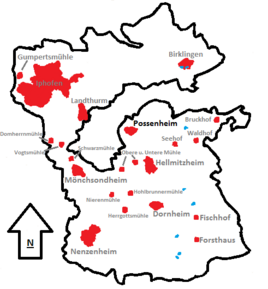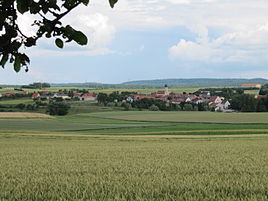Possenheim
|
Possenheim
City of Iphofen
Coordinates: 49 ° 41 ′ 1 ″ N , 10 ° 18 ′ 51 ″ E
|
|
|---|---|
| Height : | 294 m above sea level NN |
| Residents : | 211 (December 31, 2012) |
| Incorporation : | January 1, 1972 |
| Postal code : | 97346 |
| Area code : | 09326 |
|
Location of Possenheim (bold) in the Iphöfer municipality
|
|
|
Possenheim
|
|
Possenheim is a district of the city of Iphofen in the Lower Franconian district of Kitzingen .
geography
Possenheim is a parish village on Bundesstraße 8 . The Moorseebach runs north of the village and rises north of the Bühl mountain ( 352 m above sea level ) in the Kesselholz forest. Possenheim belongs to the Hellmitzheim Bay . This pushes itself deep into the Steigerwald and opens westwards to the Main valley.
The village of Kirchheim lies on the boundary of Markt Einersheim . The village was abandoned in the 13th century. Something similar is assumed for the Eckelsheim desert . To the east of the village was the monk's hut , which was also abandoned.
In terms of nature, Possenheim lies in the Schwanberg foreland , which is characterized by smaller hills.
history
The ending -heim of the place name indicates the foundation at the time of the Franconian conquest . The place was mentioned in writing for the first time in 1171 in a Bamberg document.
In 1414 the Counts of Castell and the taverns of Limpurg shared the place.
From 1435 Possenheim belonged to the domain of the Counts of Speckfeld . They introduced the Reformation in the village in 1535 . There were armed conflicts over denomination. The residents suffered particularly during the Thirty Years' War .
The important east-west connection from Nuremberg to Frankfurt, the Alte Reichsstrasse , ran through the town. A rest and horse-changing station of the Imperial Post Office operated by Thurn und Taxis is said to have existed in the village before 1627, but can only be verified in 1627. With the construction of the railway from Würzburg to Nuremberg in 1865 it became superfluous.
Population development
In 1846 the place had 255 inhabitants. 54 families lived in 45 houses.
Culture and sights
Architectural monuments
Branch church
A branch church of the parish of Markt Einersheim is mentioned in the sources as early as 1340 . The pastor from "Eynersheymb" was obliged to hold church services in "Poßne". On August 1, 1710, Possenheim received an independent parish through the foundation of Schenk Vollrath von Limpurg- Speckfeld.
From 1773, the villagers collected for a new building. In 1778 the Würzburg master builder Josef Albert from Wiesentheid received the building contract for today's church building. After the altar, pulpit and organ had also been created, the inauguration took place on October 24, 1784. The hall building has a facade tower and a choir closed on three sides.
During the renovation in 1963, the interior was completely redesigned. Some features of the margrave style disappeared completely. The galleries on the left and right as well as the organ gallery above the altar were removed. The musical instrument was given its current place on the gallery opposite the choir. The pulpit was sold to Lichtenstein in the Haßberge. It is not known where the altar with the image of the resurrection went. The old wooden font and chandelier were rediscovered twenty years later and brought back to the house of God. During the renovation, the church received a modern design of the altar, pulpit and baptismal font.
Community center
The present town house was built in 1685. The substance suffered greatly from various uses in the past. The city of Iphofen bought the historic building; she refurbished and renovated it at great expense. In 1999, the residents of Possenheim were given the house with its interesting half-timbered structure for use.
legend
Similar to Sickershausen, there is also a legend in Possenheim about a so-called Jewish fountain.
In the past few days, a farmer lived on the Schlossberg near Possenheim. He had borrowed money from a Jew , but did not repay his debts despite repeated reminders. Thereupon the Jew ran up the Schlossberg and threatened the farmer to sue him in court . The farmer got angry at this and killed the Jew. The dying man said: "Even if no one sees your deed, the sun must betray you!"
Whenever the sun was shining , the farmer smiled. His wife noticed, but couldn't see why. One day she flattered him so much that he told everything. Whenever the sun rises, he always had to smile at the Jew's stupidity. Now the wife knew about the murder of the farmer and when they were arguing once she said: "Will you do it to me like the Jew you killed and thrown into the well ?"
This was also heard by the farmer's servants and reported to their masters in court. But the farmer fled and was never seen again in Possenheim. The so-called Jewish well, into which the farmer is said to have thrown his creditor, was still in place at the beginning of the 20th century. It was filled in before 1912. There was also the legend that the farmer and the Jew appear at the place of the fountain at midnight .
Economy and Infrastructure
Viticulture
Possenheim is now a wine-growing area in the Franconian wine-growing region . There is a vineyard around the village, the wine has been marketed under the name Possenheimer Mönchshütte (formerly Stüblein) since the 2000s. Possenheim is part of the Schwanberger Land area, until 2017 the winemakers were grouped together in the Steigerwald area. The Keuperböden around Possenheim are just as suitable for growing wine as the location in the Maingau climate zone, which is one of the warmest in Germany.
The people around Iphofen have been growing wine since the early Middle Ages . The Franconian settlers probably brought the vine to the Main in the 7th century. In the Middle Ages, the region was part of the largest contiguous wine-growing region in the Holy Roman Empire, although Possenheim itself was not a large wine-growing community. The people mostly operated part-time viticulture for self-sufficiency . A central market for wine was established in nearby Iphofen.
Viticulture experienced a major decline after secularization at the beginning of the 19th century. Above all, locations with less favorable climatic conditions were completely abandoned. In addition, the emergence of pests such as phylloxera made cultivation difficult , so that viticulture in Possenheim soon disappeared completely. The Franconian wine-growing region was not able to consolidate again until the second half of the 20th century. The use of fertilizers and improved cultivation methods had contributed to this, as had the organization in cooperatives and the land consolidation of the 1970s. Instead of a wine festival , the people of Possenheim hold the so-called wine enjoyment with music and wine in the middle of June.
| Vineyard | Size 2019 | Compass direction | Slope | Main grape varieties | Great location |
|---|---|---|---|---|---|
| Monk's hut | 12 ha | south | not clear | not clear | Iphöfer Burgweg |
traffic
In a bypass, the federal road 8 leads past Possenheim. The Keuper tour on the Kitzinger Land border hiking map touches the place.
societies
Community House Association
Since 2001 the association "Bürgerhaus Possenheim eV" has been taking care of the diverse uses of the historic building:
- Meeting point for clubs
- Offer for local tradition and culture maintenance,
- Inn
- Place for family celebrations
fire Department
The voluntary fire brigade Possenheim serves to protect their place with their exercises. She also arranges the following celebrations:
- Midsummer bonfire
- Summer party with Preischafkopf
- Fair Friday with slaughter bowl and prize sheep head
- Cycling and hiking tours
Trumpet Choir
At the suggestion of Dean Hans Sommer, ten people came together on February 9, 1978 to found a trombone choir. The group made their first public appearance on Thanksgiving that same year. The 30th anniversary was celebrated on April 20, 2008.
youth
In 2002 the Possermer Jugend e. V. founded. Its main task is the responsibility for the youth room in the community center as well as the preservation of the local customs. Its own beat evenings, the Metal Maniax, have also been organized since 2003.
Country women
The rural women are an integral part of the village community thanks to a variety of activities such as training for women, sociable craft evenings and active help at the village festivals.
literature
- Hans Ambrosi, Bernhard Breuer: German Vinothek: Franconia. Guide to the vineyards, winegrowers and their kitchens . Herford 2 1993.
- District of Kitzingen (ed.): Art and culture guide through the district of Kitzingen . 2nd Edition. Color printing Brühl, Marktbreit 1993.
- Johann Ludwig Klarmann, Karl Spiegel: Legends and sketches from the Steigerwald. Reprint of the 1912 edition . Neustadt an der Aisch 1982.
Web links
Individual evidence
- ^ Fritz Ortner: Illustrated guide through market Einersheim and its history . Ed .: Markt Markt Einersheim. Hügelschäffer printing works, Mainbernheim 1986.
- ↑ Susanna Berger: The Iphöfer districts . Possenheim. In: District Kitzingen (ed.): Art and culture guide through the district Kitzingen . 2nd Edition. Color printing Brühl, Marktbreit 1993.
- ^ A b Holger Lang, Martin Ost, Willi Dingeldein: The Evangelical Church in Possenheim . Ed .: Church Council. Self-published, Markt Einersheim 1997.
- ↑ a b c Possenheim. History of Possenheim. (No longer available online.) Bernd Adler, Martin Fink, archived from the original on October 30, 2013 ; Retrieved May 27, 2013 . Info: The archive link was inserted automatically and has not yet been checked. Please check the original and archive link according to the instructions and then remove this notice.
- ^ Eduard Vetter: Statistical handbook and address book of Middle Franconia in the Kingdom of Bavaria . Eduard Vetter. Self-published, Ansbach 1846, p. 269 ( online [accessed June 17, 2013] Sign .: Bavar. 2696).
- ↑ a b c d e f Possenheim. History of Possenheim. (No longer available online.) Bernd Adler, Martin Fink, archived from the original on October 22, 2013 ; Retrieved May 27, 2013 . Info: The archive link was inserted automatically and has not yet been checked. Please check the original and archive link according to the instructions and then remove this notice.
- ↑ Klarmann, Johann Ludwig (among others): Legends and sketches from the Steigerwald . P. 125.
- ^ Ambrosi, Hans (among others): German Vinothek: Franconia . Pp. 50-52.
- ^ Government of Lower Franconia: Vineyards in Bavaria broken down by area , PDF file, accessed on May 16, 2019.








